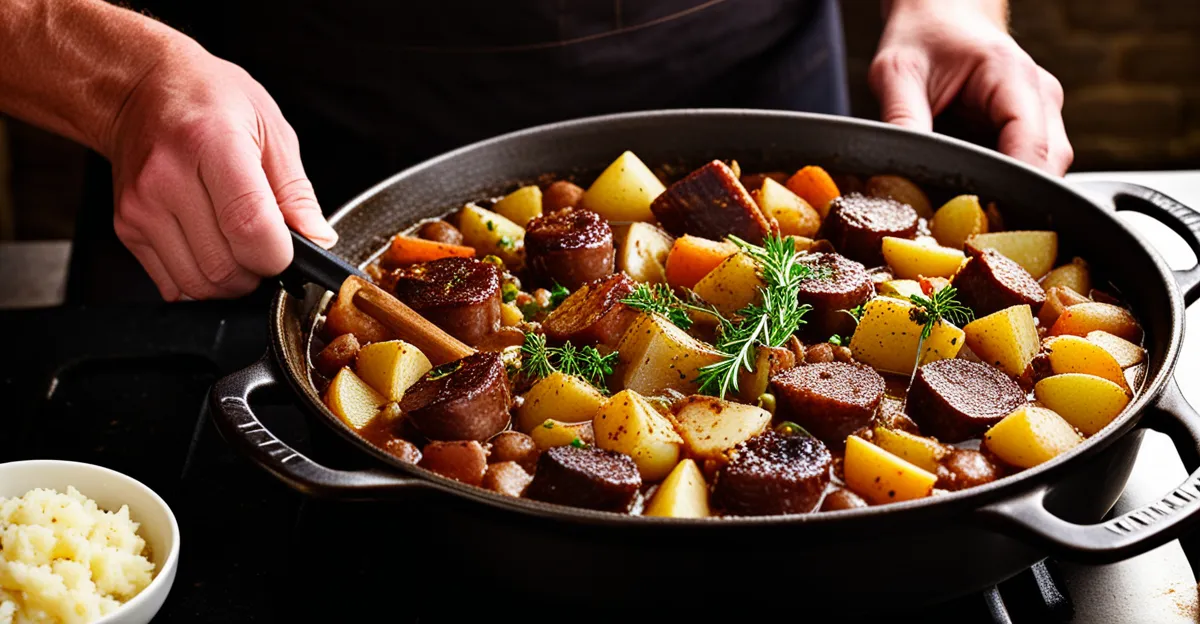Understanding the Traditional Lancashire Hotpot
Lancashire hotpot, a staple in British cuisine, boasts a rich history intertwined with the cultural fabric of Lancashire, England. Originating during the Industrial Revolution, this dish provided sustenance to workers who needed a hearty meal to fuel their labor-intensive days. Traditionally made in a single pot, its simplicity afforded practicality and nourishment, helping it to become a familial and communal favorite over generations.
The cultural significance of Lancashire hotpot extends beyond its role as a meal. It embodies regional pride and culinary heritage, often being featured in local festivals and family gatherings. As a symbol of warmth and hospitality, the Lancashire hotpot is celebrated for its robust flavors and comforting nature, encapsulating the spirit of togetherness synonymous with British home cooking.
Also read : How can you create the perfect Sunday roast with all the trimmings?
The hallmark of any authentic Lancashire hotpot lies in its traditional recipes and carefully chosen ingredients. Lamb is the meat of choice, renowned for lending a rich and tender texture, although beef serves as a common variant. The dish incorporates root vegetables such as potatoes, onions, and occasionally carrots, sourced locally from the fertile lands of Lancashire. These ingredients not only reflect the agricultural bounty of the region but contribute to the hotpot’s quintessential taste profile. The simplicity of seasoning—typically salt, pepper, and bay leaves—allows the natural flavors to shine, delivering a hearty and wholesome experience.
Ingredients for the Perfect Lancashire Hotpot
Crafting the perfect Lancashire hotpot begins with the careful selection of ingredients, a process steeped in tradition. The choice of meat is pivotal; lamb is the classic option praised for its rich, tender texture, while beef provides a robust alternative, each imbuing the dish with distinct flavors. When debating on hotpot ingredients, meat selection remains a cornerstone.
Also to read : What are some iconic UK desserts to try at home?
Root vegetables forge the comforting foundation of this dish. Potatoes, a staple, lend a creamy consistency and absorb the flavorful juices. Onions contribute sweetness, while carrots add a subtle contrast. Sourcing these vegetable choices locally harnesses the fertile bounty of the region, aligning with the hotpot’s legacy.
Seasoning is deliberately simple yet effective. Salt and pepper highlight the flavors, and a touch of bay leaves introduces an aromatic depth. The importance of using local and seasonal ingredients cannot be overstated, as they ensure freshness and authenticity, vital for a hotpot that embodies the essence of Lancashire cuisine.
Cooking Techniques for an Authentic Hotpot
Achieving the perfect Lancashire hotpot involves selecting the right cooking methods to enhance the dish’s flavor and texture. You might debate between using the oven or the stovetop; each has its distinct benefits. The oven offers even heat distribution, lending a consistent cook and beautifully golden crust. Alternatively, the stovetop can provide a more hands-on approach, allowing you to monitor and adjust the temperature actively.
Slow cooking is essential in this traditional dish as it allows flavors to meld over time, resulting in rich, mouth-watering outcomes. By simmering gently, the lamb becomes tender, and the potatoes absorb the juices, creating a harmonious balance of components. This method aids in moisture retention, ensuring the hotpot remains succulent without drying out.
Throughout the cooking process, it is vital to monitor the hotpot closely. Keep an eye on the cooking time, as overcooking may lead to mushy vegetables and a loss of texture. Adjust the heat as necessary, especially if you notice the liquid levels depleting; adding a bit of stock can help maintain the desired consistency. By understanding these techniques, you can craft a Lancashire hotpot that is both authentic and satisfying, capturing the essence of its storied tradition.
Variations of the Lancashire Hotpot
Exploring Vegetarian and Vegan Variations of the classic Lancashire hotpot opens a world of culinary creativity while maintaining its cozy essence. Swapping out lamb or beef for hearty ingredients like lentils or chickpeas not only caters to vegetarian preferences but also enhances the dish’s nutritional value. These legumes deliver substantial protein and a rich texture, ensuring a satisfying meal without the meat. Incorporating a variety of seasonal vegetables such as mushrooms, parsnips, and leafy greens can enrich the flavors and offer different textures within the pot.
Engaging in experimental recipes can breathe new life into the traditional hotpot. For a modern twist, consider the addition of international spices or herbs such as cumin or rosemary. These combinations can diversify the taste and introduce vibrant flavors that complement the comforting roots of the dish. Additionally, using alternative cooking oils like coconut or olive oil can subtly adjust the flavor profile while remaining true to the hotpot’s hearty character.
Regional adaptations show the hotpot’s versatility across the UK. In some regions, you’ll find the inclusion of black pudding or local sausages, each adding its unique influence. These adaptations not only reflect the cultural significance of the dish in various locales but also showcase its ability to incorporate local preferences and ingredients, making it a true culinary chameleon.
Step-by-Step Guide to Crafting Lancashire Hotpot
Creating a classic Lancashire hotpot requires careful attention to each component, ensuring the dish’s tradition is upheld through expert preparation techniques.
Preparing the Meat
The foundation of the perfect Lancashire hotpot begins with the selection and preparation of meat. Lamb is a traditional choice, thanks to its rich texture and flavour. When preparing the lamb, trim excess fat and cut it into consistent pieces. Season the lamb generously with salt and pepper, and let it marinate briefly to enhance its natural taste.
Layering the Vegetables
Layering is key to a well-cooked hotpot. Start with a base of sliced potatoes to prevent sticking and add a layer of seasoned lamb. Alternate with slices of onions and more potatoes, seasoning each layer lightly. Lastly, carrots or other root vegetables may be included for added texture and sweetness. The careful arrangement of layers is crucial in allowing flavors to meld during cooking.
Creating the Topping
A defining characteristic of this dish is its crispy potato topping. Arrange a layer of thinly sliced potatoes over the final set of meat and vegetables, overlapping slightly to create a beautiful crust. Brush the potato slices with a bit of melted butter or olive oil. This step helps achieve a golden brown finish in the oven and adds richness to the dish.
Serving Suggestions and Pairings
The Lancashire hotpot is not just about the delectable medley it offers within; it also shines brightly when paired with the right accompaniments, elevating your dining experience to new heights. Here are some delightful ideas to consider when serving traditional hotpot.
Complementary Side Dishes
To enhance the warm, robust flavors of the hotpot, consider including a side of crusty bread. Its chewy texture is perfect for soaking up the rich juices. If you prefer something tangy, pickles or a chutney with a hint of sweetness can provide a refreshing contrast. These sides complement the hotpot’s depth, creating a balanced meal.
Garnishing and Presentation
To enrich the aesthetic appeal and taste, garnishing your hotpot with fresh parsley or a sprig of thyme adds a pop of color and a hint of herbaceous aroma. Lemon zest is another option that can subtly brighten the hotpot’s hearty flavors, making the meal not only delicious but pleasing to the eyes.
Beverage Pairings
Pair your hotpot with beverages that can accentuate its flavors. A robust red wine, such as a Bordeaux or a Merlot, echoes the dish’s earthy tones, while a crisp cider introduces a refreshing note. For non-alcoholic options, a sparking apple juice serves as an excellent palate cleanser.
With these thoughtful additions, your Lancashire hotpot meal can transform from comforting to truly memorable, offering both tradition and tasteful innovation.
Nutritional Information and Health Considerations
Understanding the nutritional value of a traditional Lancashire hotpot is crucial for those mindful of their dietary intake. Generally, this beloved dish offers a substantial source of protein due to its meat content, especially if lamb or beef is used. Proteins are essential for muscle repair and overall body function, making the hotpot a viable option for those seeking a hearty meal rich in this nutrient.
For individuals aiming for a healthier alternative, consider swapping out fatty meat cuts for leaner portions or entirely substituting meat with plant-based proteins like lentils or chickpeas. This adjustment not only reduces caloric intake but also increases dietary fiber, aiding digestion. Additionally, incorporating extra seasonal vegetables can boost vitamin and mineral content, enhancing the hotpot’s nutritional profile without compromising its core appeal.
Portion control plays a significant role in maintaining a balanced diet. By keeping serving sizes moderate and pairing the hotpot with a side salad or steamed greens, you ensure a meal that’s satisfying yet nutritionally balanced. This approach supports a holistic dietary practice, allowing the enjoyment of beloved cultural dishes like the Lancashire hotpot while prioritizing health.




